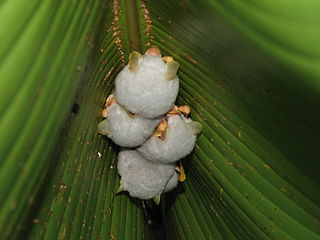
The Honduran white bat, also called the Caribbean white tent-making bat, is a species of bat in the family Phyllostomatidae. It is the only member of the genus Ectophylla. The genus and the species were both scientifically described for the first time in 1892. It has distinctive, entirely white fur, which is only found in six of the roughly 1,300 known species of bat. It constructs "tents" out of understory plant leaves by strategically cutting the leaf ribs with its teeth; it roosts in these tents during the day. It is a specialist frugivore, consuming almost exclusively the fruits of one species of fig. Females can likely become pregnant twice per year, giving birth to one offspring at a time.

The black-winged little yellow bat is a species of vesper bat native to Central America.

Allen's yellow bat is a species of vesper bat. There is some taxonomic debate surrounding this species, with some authors considering Baeodon a genus rather than a subgenus. It is endemic to Mexico.

Genoways's yellow bat is a species of vesper bat found only in Mexico. It is threatened by habitat loss. Due to its imperiled status, it is identified by the Alliance for Zero Extinction as a species in danger of imminent extinction.

The little yellow bat is a species of vesper bat found only in Mexico.
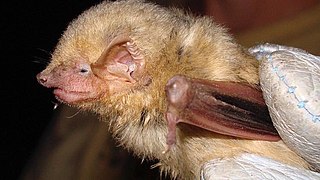
The western yellow bat is a species of vesper bat found in Mexico and the southwestern United States. This species roosts in trees such as Populus fremontii, Platanus wrightii, and Quercus arizonica. If available, the western yellow bat will use the dead fronds that encircle palm trees as a roosting site.

Van Gelder's bat or Van Gelder's big-eared bat is a species of vesper bat in the family Vespertilionidae. It is found in Belize, Costa Rica, Honduras, and Mexico. The species is monotypic within its genus. It is part of the tribe Antrozoini within the subfamily Vespertilioninae and is related to the pallid bat. The bat is found in forest habitat from sea level to elevations as high as 2300 m, although not usually above 1300 m, and is insectivorous and crepuscular. It apparently has a fragmented distribution, and is threatened by deforestation.

The Mexican long-tongued bat is a species of bat in the family Phyllostomidae. It is the only species within the genus Choeronycteris. The species is found in El Salvador, Guatemala, Honduras, Mexico, and the United States.
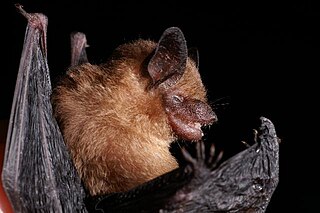
Rhogeessa is a genus of bats within the vesper bats family, Vespertilionidae.

The Yucatan yellow bat is a species of bat found in the Yucatán Peninsula in Mexico, and possibly also in Belize and Guatemala. These small insectivorous bats forage on flying insects at dawn and dusk.
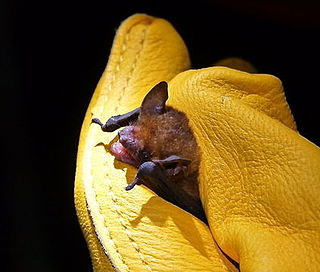
Thomas's yellow bat is a species of bat from the family Vespertilionidae.

The Cozumelan golden bat is a bat species found in Mexico, Guatemala, Belize, Honduras, Nicaragua, Costa Rica, Panama and Colombia. At one time, this species was considered to be a subspecies of the golden bat. Little is known about the biology of this bat, but it has a wide range, no particular threats have been identified, and the population seems steady, so the International Union for Conservation of Nature has assessed its conservation status as being of "the least concern".

Husson's yellow bat is a species of vesper bat found in Suriname and southern Brazil.

The Mexican greater funnel-eared bat is a species of bat found in Central America. While initially and currently described as a species, from 1959 to 2006 it was considered a subspecies of the Mexican funnel-eared bat, Natalus stramineus.
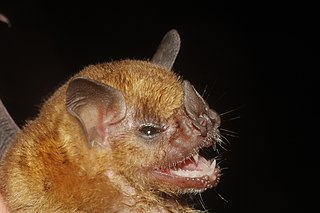
Sturnira honurensis is a species of bat found in Central America. Previously, it was considered a subspecies of the highland yellow-shouldered bat, but it has been considered distinct since 2010.

Bickham's little yellow bat is a species of vesper bat found in Central America.
Rhogeessa velilla, also called the Ecuadorian little yellow bat, is a species of vesper bat in the genus Rhogeessa. It is found in Northwestern Peru and parts of Ecuador. The species was previously included in R. io, but is now recognized as a separate species. Very little is known about this species, though it is generally considered to be insectivorous.
















